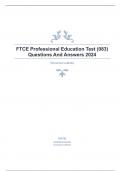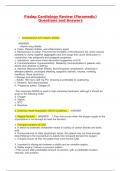FTCE Professional Education Test (083)
Questions And Answers 2024
[Document subtitle]
[DATE]
[COMPANY NAME]
[Company address]
,reliability - Answers:the consistency of a measurement over time and repeated
measurements
validity - Answers:can be determined by comparing a test score against some separate
or independent observation of whatever is being measured
unbiased test - Answers:a test that does not unfairly favor a particular group
standardized test - Answers:a test that has been carefully constructed and field-tested
so that (ideally) it has a high degree of reliability and validity
mean - Answers:determined by adding up all the scores and dividing this sum by the
total number of scores that were added
median - Answers:the midpoint in a distribution of scores from highest to lowest
range - Answers:the greatest score minus the least score in a set of scores; the
simplest measure of variability
standard deviation - Answers:a measure of dispersion of a set of data values about the
mean of the data set
raw score - Answers:the total number of correct responses on an assessment
z-score - Answers:the distance in standard deviations from the mean of the scores on
the assessment; (raw score - mean) / standard deviation
percentile - Answers:a value at or below which P percent of the data fall
quartile - Answers:values that divide an ordered data set into four portions, each of
which contains approximately 1/4 of the data
stanine scores - Answers:scores derived from percentiles; compare test performance
using nine intervals that are numbered 1 to 9
grade equivalent score - Answers:used to describe student's performance in
comparison to the performance of an average student at a specified grade level
formative assessment - Answers:occurs before and during instruction
diagnostic assessment - Answers:administered before instruction and are designed to
identify students' strengths and weaknesses (e.g., pre-tests, student interviews, learning
style inventories)
,Florida School Readiness Uniform Screening System (SRUSS) - Answers:requires that
new kindergarten students in Florida public schools be assessed for school readiness at
the beginning of the school year (ESI-K and DIBELS)
summative assessment - Answers:most often used to determine students' academic
achievement in each class or course, often for the purpose of grades (e.g., student
projects, unit and chapter tests, standardized tests)
performance assessment - Answers:same as authentic assessment; long been used in
assessment of music, art, drama, and physical education
process/product assessment - Answers:same as authentic assessment; long been used
in science, math, social studies, and language arts
instructionally embedded assessment - Answers:(aka teacher observation) uses
systematic observational methods along with checklists, interviews, and questioning
while students are engaged in learning activities
critical and creative thinking - Answers:higher level thinking skills that Florida students
need in all subject areas and as preparation for everyday life, including the world of
work
critical thinking - Answers:the mental process of making reasoned judgments and
reaching objective conclusions by analyzing, organizing, comparing, synthesizing,
logically examining, challenging, and evaluating assumptions and evidence
creative thinking - Answers:the mental process of generating new ideas, recognizing
and finding solutions to problems, and making informed decisions
divergent questions - Answers:open-ended questions that allow many correct
responses (good)
convergent questions - Answers:closed-ended questions that have a limited number of
correct responses (bad)
Bloom's taxonomy - Answers:higher order thinking skills: knowledge, comprehension,
application, analysis, synthesis, and evaluation
knowledge level thinking - Answers:involves recalling or remembering information
comprehension level thinking - Answers:involves making interpretations of previously
learned material
application level thinking - Answers:involves applying knowledge to produce a result
, analysis level thinking - Answers:involves subdividing knowledge to show how it fits
together
synthesis level thinking - Answers:involves putting together ideas or elements to form a
whole
evaluative level thinking - Answers:involves judging the quality of an idea or solution
brainstorming - Answers:a teaching strategy in which students generate ideas around a
specific topic of interest
deductive reasoning - Answers:the process of using an accepted rule to draw a
conclusion about a specific example
inductive reasoning - Answers:the process of drawing a general conclusion based on
one or more examples
logical reasoning - Answers:the higher level thinking processes that are used to make
decisions or draw conclusions
syllogistic reasoning - Answers:a form of deductive reasoning consisting of a major
premise, a minor premise, and a conclusion
cognitive complexity - Answers:the level of cognitive demand associated with test items
cognitive complexity classification - Answers:low complexity (recall, identify, locate,
recognize); moderate complexity (demonstrate comprehension); high complexity
(demonstrate the use of higher order thinking skills including abstract reasoning
The Natural Approach (ESOL) - Answers:students acquire a new vocabulary through
experiences and associations with words because the words are used in meaningful
ways and contexts.
Cognitive Academic Language Learning Approach (CALLA) - Answers:assists the
students in the transition from a language arts program in which the content is made
comprehensible through the use of ESOL strategies
Scaffolding (ESOL) - Answers:students should be provided with steps of learning that
allow for consolidation and success.
Performance-based Assessment - Answers:Allows students to use higher-level thinking
skills to apply, analyze, synthesize, and evaluate ideas and data
Metacognition - Answers:A term used to describe what, how, and why people know
what they know when they know it.





